FfE Discussion Paper: Development Framework of Household Electricity Prices in Germany
The development of household electricity prices is a frequent and often controversial topic in Germany. The focus is usually on the tension between the distribution effects of the energy transition and the setting of the right incentives for decarbonization among private end consumers. For evaluating possible costs from the consumer’s point of view as well as existing and new business models in the environment of the transformation of the energy system, the development of household electricity prices is of essential importance.
In order to estimate and evaluate the level of future household electricity prices, this FfE Discussion Paper presents a basic methodology for establishing a development framework for German household electricity prices. A methodological procedure is described to develop possible price paths by oneself. Based on the discussion and analysis of the most important price components of household electricity prices, two extreme development paths – a maximum and a minimum price path – are created on the one hand. On the other hand, a plausible path (best guess of the authors) of the price development is presented. The following figure illustrates the methodological procedure and presents the resulting development framework.

As a result of the methodical approach with current input data, a development framework of between 19 and 30 ct/kWh is established, which thus does not indicate any real increase in household electricity prices compared with the status quo, even in the event of very unfavorable developments. In particular, savings resulting from the abolition of the EEG surcharge, which will not be offset by possible increases in energy procurement costs and rising grid usage fees, indicate a reduction in costs from the end consumer’s perspective in the coming years. However, due to the renewed upward trend for all development paths from 2030 onwards, it cannot be ruled out from today’s perspective that the household electricity price could rise above the previous real peak value after 2040.
In addition to estimating German household electricity prices up to 2040, the aim of the paper is to create an understanding of the main techno-economic and political drivers and their possible ranges. In this way, readers are given the tools to create their own price developments as simply and well-founded as possible based on the methodology presented and using current developments. To update the development framework, the methodology can be re-applied at any time using current sources and input data.


